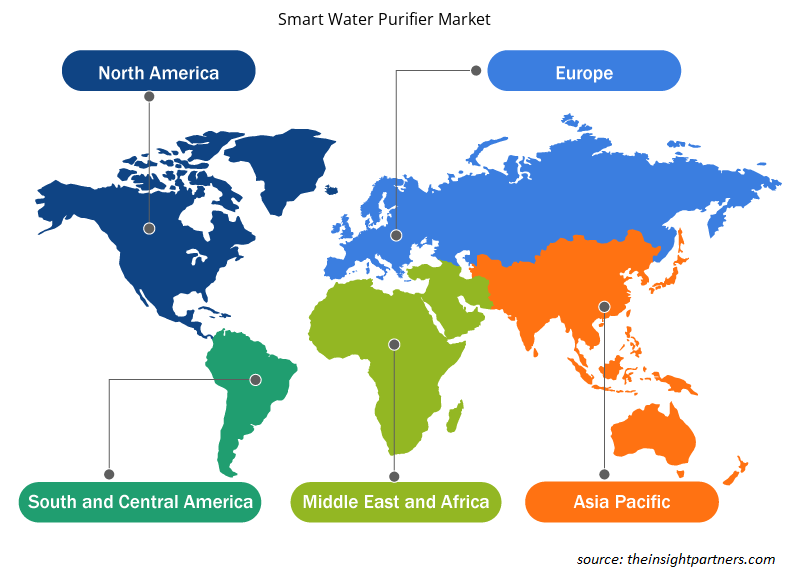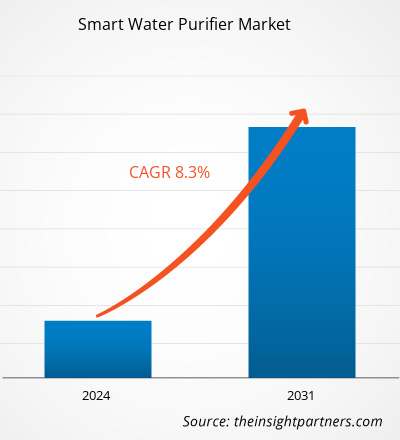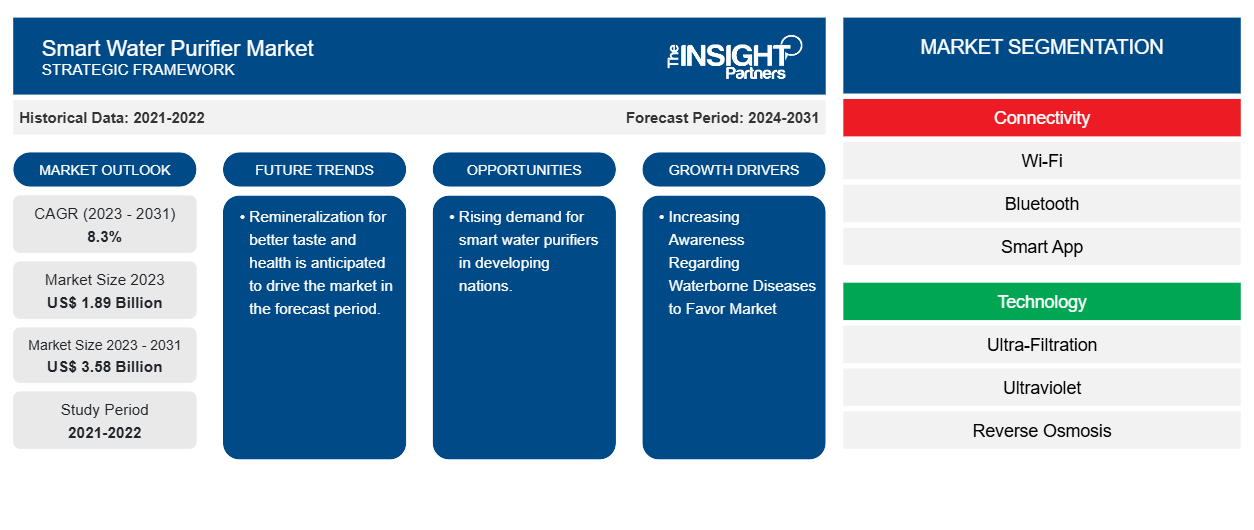智能净水器市场规模预计将从 2023 年的 18.9 亿美元增至 2031 年的 35.8 亿美元。预计 2023-2031 年期间,该市场的复合年增长率将达到 8.3%。人们对水传播疾病的认识不断提高以及技术的不断进步可能是市场的主要趋势和驱动力。
智能净水器市场分析
全球范围内,智能净水器市场正在经历显著增长。这种增长归因于人们对水传播疾病的认识不断提高以及技术不断进步。此外,发展中国家对智能净水器的需求不断增长,以及为了改善口感和健康而进行的再矿化,预计将在未来几年推动市场增长。
智能净水器市场概览
家用智能净水器采用先进的过滤技术去除水中的杂质。它们通常结合使用反渗透 (RO)、活性炭和其他先进过滤器来去除细菌、病毒、化学物质和重金属等杂质。
定制此报告以满足您的需求
您可以免费定制任何报告,包括本报告的部分内容、国家级分析、Excel 数据包,以及为初创企业和大学提供优惠和折扣
-
获取此报告的关键市场趋势。这个免费样品将包括数据分析,从市场趋势到估计和预测。
智能净水器市场驱动因素和机遇
提高对水传播疾病的认识有利于市场
人们对水传播疾病的认识不断提高,这确实推动了智能净水器市场的发展。由于污染,水传播疾病的数量正在增加,对智能净水器的需求也在增加。受污染的水和恶劣的卫生条件与霍乱、腹泻、痢疾、甲型肝炎、伤寒和脊髓灰质炎等疾病的传播有关。为了控制水传播疾病的增长,许多企业都在投资水净化系统,如反渗透智能净化器、UV(紫外线)智能净化器和UF(超滤)智能净化器。因此,考虑到上述参数,人们对水传播疾病的认识不断提高,正在推动市场增长。
发展中国家对智能净水器的需求不断增加。
发展中国家对智能净水器的需求不断增长,预计将为智能净水器市场带来诸多机遇。人们对清洁水消费好处的认识不断提高,工业化和城市化以及政府的举措和活动正在推动全球市场的发展。此外,水传播疾病的数量不断增加,特别是在发展中国家,这进一步推动了市场的增长。随着城市化的发展,发展中国家对智能净水器的需求也在增加。因此,由于上述参数,发展中国家对智能净水器的需求预计将在市场上带来诸多机遇。
智能净水器市场报告细分分析
有助于得出智能净水器市场分析的关键部分是连接性、技术、最终用户和销售渠道。
- 根据连接性,智能净水器市场分为 Wi-Fi、蓝牙和智能应用。预计 Wi-Fi 部分将在预测期内占据相当大的市场份额。
- 根据技术,智能净水器市场分为超滤 (UF)、紫外线 (UV)、反渗透、多级净化器等。预计超滤 (UF) 部分将在预测期内占据相当大的市场份额。
- 根据最终用户,市场分为住宅、商业和工业)、销售渠道(零售店、直销和在线)。预计住宅部门将在预测期内占据相当大的市场份额。
- 根据销售渠道,市场分为零售店、直销和在线销售。预计零售店部分将在预测期内占据相当大的市场份额。
智能净水器市场份额(按地区)分析
智能净水器市场报告的地理范围主要分为五个区域:北美、亚太、欧洲、中东和非洲、南美和中美。
北美在智能净水器市场占据主导地位。北美地区各行业的高科技采用趋势推动了智能净水器的增长。该地区对水传播疾病的认识不断提高,技术也不断进步。此外,数字工具的采用率提高和政府机构在技术方面的高投入等因素预计将推动北美智能净水器市场的增长。此外,美国和加拿大等发达经济体高度重视研发,这迫使北美参与者将技术先进的解决方案引入市场。此外,美国拥有大量工程软件市场参与者,他们越来越专注于开发创新解决方案。所有这些因素都促进了该地区智能净水器市场的增长。
智能净水器市场区域洞察
Insight Partners 的分析师已详细解释了预测期内影响智能净水器市场的区域趋势和因素。本节还讨论了北美、欧洲、亚太地区、中东和非洲以及南美和中美洲的智能净水器市场细分和地理位置。

- 获取智能净水器市场的区域具体数据
智能净水器市场报告范围
| 报告属性 | 细节 |
|---|---|
| 2023 年的市场规模 | 18.9亿美元 |
| 2031 年市场规模 | 35.8亿美元 |
| 全球复合年增长率(2023 - 2031) | 8.3% |
| 史料 | 2021-2022 |
| 预测期 | 2024-2031 |
| 涵盖的领域 |
按连接性
|
| 覆盖地区和国家 |
北美
|
| 市场领导者和主要公司简介 |
|
智能净水器市场参与者密度:了解其对业务动态的影响
智能净水器市场正在快速增长,这得益于终端用户需求的不断增长,而这些需求又源于消费者偏好的不断变化、技术进步以及对产品优势的认识不断提高等因素。随着需求的增加,企业正在扩大其产品范围,进行创新以满足消费者的需求,并利用新兴趋势,从而进一步推动市场增长。
市场参与者密度是指在特定市场或行业内运营的企业或公司的分布情况。它表明在给定市场空间中,相对于其规模或总市场价值,有多少竞争对手(市场参与者)存在。
在智能净水器市场运营的主要公司有:
- 维珍纯净
- 3M
- AO 史密斯水务技术公司
- LG 电子
- Livpure Smart Homes 私人有限公司
- 膜解决方案有限责任公司
免责声明:上面列出的公司没有按照任何特定顺序排列。

- 了解智能净水器市场顶级关键参与者概况
智能净水器市场新闻和最新发展
智能净水器市场的评估是通过收集一手和二手研究后的定性和定量数据进行的,其中包括重要的公司出版物、协会数据和数据库。以下列出了智能净水器市场的一些发展情况:
- 亚洲领先的家居服务平台之一 Urban Company 推出了一系列全新智能 RO 净水器,其子品牌为 Native。Native M1 和 M2 型号专为家庭提供清洁安全的饮用水而设计,配备了尖端技术和优质过滤器,使其与众不同。(来源:Urban Company 网站,2023 年 10 月)
智能净水器市场报告覆盖范围和交付成果
“智能净水器市场规模和预测(2021-2031)”报告对以下领域进行了详细的市场分析:
- 智能净水器市场规模及全球、区域和国家层面所有主要细分市场的预测
- 智能净水器市场趋势以及市场动态,如驱动因素、限制因素和关键机遇
- 详细的 PEST/波特五力分析和 SWOT 分析
- 智能净水器市场分析涵盖主要市场趋势、全球和区域框架、主要参与者、法规和最新市场发展
- 行业格局和竞争分析,涵盖市场集中度、热点图分析、知名参与者以及智能净水器市场的最新发展
- 详细的公司简介
- 历史分析(2 年)、基准年、预测(7 年)及复合年增长率
- PEST和SWOT分析
- 市场规模、价值/数量 - 全球、区域、国家
- 行业和竞争格局
- Excel 数据集
近期报告
相关报告
客户评价
购买理由
- 明智的决策
- 了解市场动态
- 竞争分析
- 客户洞察
- 市场预测
- 风险规避
- 战略规划
- 投资论证
- 识别新兴市场
- 优化营销策略
- 提升运营效率
- 顺应监管趋势























 获取免费样品 - 智能净水器市场
获取免费样品 - 智能净水器市场